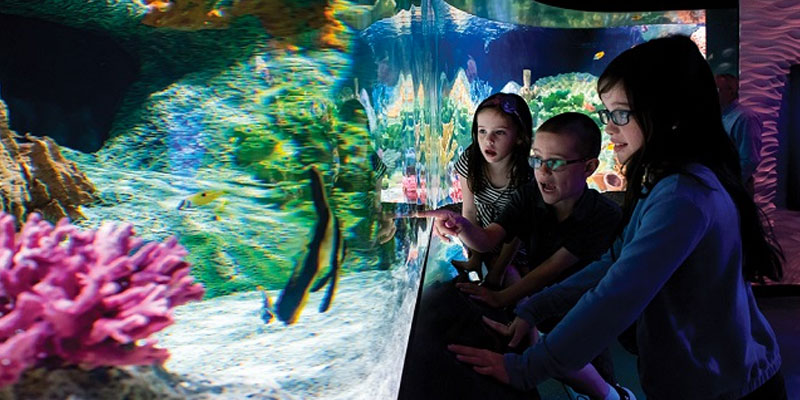Fifty years ago, it was a humble bug collection. Today, it’s a multimillion-dollar, state-of-the-art, hands-on, fully immersive museum, with more than 62,000 square feet of space dedicated to the study of all aspects of nature.
This is the Cook Museum of Natural Science in Decatur, which opened in June after being closed for three years while the new location was being planned and built. The nonprofit museum allows visitors to learn about nature through a vast array of exhibits and interactive experiences, designed to captivate kids of all ages.
In the late 1960s, John Cook Sr. of Cook’s Pest Control started opening his private collection of insects – which until then had been used primarily for employee training – by appointment to various groups in north Alabama. The collection grew to include mounted wildlife, and the original museum opened in 1980 with additional displays of rocks, minerals, fossils and insects.
In more than 30 years of existence, what was the Cook’s Natural Science Museum welcomed more than 750,000 visitors. But the Cook family was at a crossroads about the future of the old museum after Cook died in 2009.
“The Cook family had the museum for so long that they did not want to close it, but they were not sure what to do,” marketing and public relations manager Mike Taylor said.
After extensive market research, in 2015 the decision was made to build a new museum. After closing the old museum in 2016, the Cook family began moving their collection into the new museum while acquiring additional artifacts.
The biggest challenge the new attraction faces is describing the number of new features to those familiar with the original Cook Museum. “It is hard to put the museum into words,” Taylor explained. “You have to come see it.”
All about nature
There are 11 themed galleries dedicated to the diverse habitats of Alabama, the Southeast and North America, including a life-size replica of a cave and a mesmerizing collection of rocks and minerals from different parts of the world.
North Alabama’s space industry is represented by a meteorite in the new museum. Visitors in the Rivers and Streams Gallery can learn about the whooping crane, common at nearby Wheeler Wildlife Refuge. The Arctic and Desert Gallery helps the visitor compare and contrast wildlife from those regions.
Cook’s original insect collection, along with hundreds of new species of insects, is available for viewing in the Wonderful World of Insects.
Giant aquariums hold different types of jellyfish and saltwater fish in the Oceans Gallery, while a large beehive stores as many as 60,000 Italian honey bees. There are even live baby alligators acquired from an alligator reservation in south Alabama, along with displays of other reptiles from North America.
Trained staff members, including an on-site veterinarian, are tasked with humanely treating the live animals. Once the animals outgrow their space in the museum, they are released back into appropriate habitats.
Keeping kids interested
The museum’s different hands-on exhibits, which include a virtual game that involves balancing the Earth’s atmospheric conditions and a station where you can digitally design a seashell, allow visitors various ways to discover the planet.
“We put a lot of thought and money into the different types of learning showcased in the different types of exhibits,” said Kara Long, manager of collections and gallery experience.
Children can burn off energy by peering inside a life-size beaver lodge, walking on a rope bridge above a replica of a Southeastern forest or crawling around an insect-themed playground.
To get students interested in nature, classrooms feature various programs to encourage careers in science, technology, engineering and math. “Using a child’s internal motivation to explore and learn, we can help them develop an early appreciation, sense of wonder, love and respect for the natural world that is so awe-inspiring,” Taylor said.
The museum will host field trips, birthday parties and sleepovers to encourage children and young students to visit the attraction. “There is already interest from across Alabama who want to take their students on a field trip to our museum,” Taylor said.
The museum is a community center for Decatur, with a cafe and meeting space for events, and a regional attraction for north Alabama and the Southeast.
“This museum is a rising tide for north Alabama,” president and board chairman Brian Cook said. “We see this museum as being a significant part of regionalism and are thankful for the many sponsors in north Alabama and beyond who made this museum possible.”
Cook is thankful his grandfather’s legacy lives on with the new museum.
“I recently asked my grandmother if she ever imagined that opening the doors to a few small school groups or Boy Scouts back in 1968 would lead to this,” Cook said. “She laughed and said, ‘No, I never saw this happening.’”
For more information, visit www.cookmuseum.org.
(Courtesy of Alabama Living magazine)
Don’t miss out! Subscribe today to have Alabama’s leading headlines delivered to your inbox.
